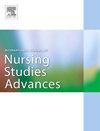Use of patient- handling devices and coworker assistance in long-term care settings: A cross-sectional study
IF 3.1
Q1 NURSING
International Journal of Nursing Studies Advances
Pub Date : 2025-03-17
DOI:10.1016/j.ijnsa.2025.100317
引用次数: 0
Abstract
Background
Although many patient handling activities require use of lifting devices and assistance from coworkers to ensure safety and efficiency, integrating these practices into the workplace remains challenging.
Objective
The objectives of this study were to examine the association of musculoskeletal symptoms with the use of patient -handling devices or coworker assistance and to identify factors associated with their adoption among direct care workers in long-term care facilities.
Methods
A cross-sectional study was conducted among 376 direct care workers recruited from 19 long-term care facilities in South Korea. Chi-square tests and analysis of variance with Tukey post-hoc analysis were used to assess differences in musculoskeletal symptom prevalence, frequency, and severity by patient handling methods. Multiple logistic regression was used to examine the relationship between the use of coworker assistance or patient -handling devices and demographic, job-related, physical, and psychosocial work factors and perception of management's safety priority.
Results
The majority of participants were female, married, and employed in non-permanent positions. Among the participants, 42.2% used both patient- handling devices and coworker assistance, 5.8 % used only patient- handling devices, 24.7 % used only coworker assistance, and 27.3 % used neither method. Workers who used both methods reported a significantly lower prevalence, frequency, and severity of musculoskeletal symptoms compared to those who relied on only one method or neither. Older and immigrant workers were less likely to use patient- handling devices. While workers perceiving management having a high priority for safety were more likely to use coworker assistance, immigrant, non-permanent, and overcommitted workers and those with longer years in long-term care showed lower tendencies to seek coworker assistance.
Conclusion
Despite the musculoskeletal benefits of using patient- handling devices and coworker assistance, their availability and adoption remain insufficient in long-term care facilities in Korea. These findings underscore the vital role that nursing leaders may play in promoting the adoption of combined patient handling methods, particularly among vulnerable worker groups. Empowerment strategies, such as fostering a supportive work environment and addressing barriers faced by overcommitted, long-tenured, and marginalized workers, may be essential to improving the safety and well-being of both patients and staff in long-term care settings.
长期护理机构中病人搬运设备和同事协助的使用情况:横断面研究
背景:虽然许多病人处理活动需要使用升降设备和同事的协助来确保安全和效率,但将这些实践融入工作场所仍然具有挑战性。目的本研究的目的是检查肌肉骨骼症状与使用病人处理装置或同事协助的关系,并确定在长期护理机构的直接护理人员中采用这些设备的相关因素。方法对来自韩国19家长期护理机构的376名直接护理人员进行横断面研究。采用卡方检验和Tukey事后分析方差分析,通过患者处理方法评估肌肉骨骼症状的患病率、频率和严重程度的差异。使用多元逻辑回归来检验同事协助或病人处理设备的使用与人口统计、工作相关、身体和心理社会工作因素以及管理安全优先级的感知之间的关系。结果大多数参与者为女性,已婚,非固定职位。在参与者中,42.2%的人同时使用病人处理装置和同事协助,5.8%的人只使用病人处理装置,24.7%的人只使用同事协助,27.3%的人两者都不使用。与只使用一种方法或两种方法都不使用的工人相比,使用这两种方法的工人报告的肌肉骨骼症状的患病率、频率和严重程度显著降低。老年人和移民工人较少使用病人处理设备。当员工认为管理层对安全有高度的优先级时,他们更有可能使用同事的帮助,而移民、非永久性和过度投入的员工以及那些长期护理时间较长的员工则更倾向于寻求同事的帮助。结论:尽管使用病人处理装置和同事协助对肌肉骨骼有好处,但在韩国的长期护理机构中,它们的可用性和采用程度仍然不足。这些发现强调了护理领导者在促进采用综合病人处理方法方面的重要作用,特别是在弱势工作者群体中。赋权战略,如营造支持性的工作环境,解决过度投入、长期任职和边缘化工作者面临的障碍,可能对改善长期护理环境中患者和工作人员的安全和福祉至关重要。
本文章由计算机程序翻译,如有差异,请以英文原文为准。
求助全文
约1分钟内获得全文
求助全文
来源期刊

International Journal of Nursing Studies Advances
Nursing-General Nursing
CiteScore
5.80
自引率
0.00%
发文量
45
审稿时长
81 days
 求助内容:
求助内容: 应助结果提醒方式:
应助结果提醒方式:


